Brand loyalty is something all suppliers strive for, the ultimate demonstration of a sound product backed by genuine people. When it comes to New Zealand‘s unique enclave of the International brand, you won‘t find loyalty in much bigger doses than from Brian Aitchison, MMM Cartage.
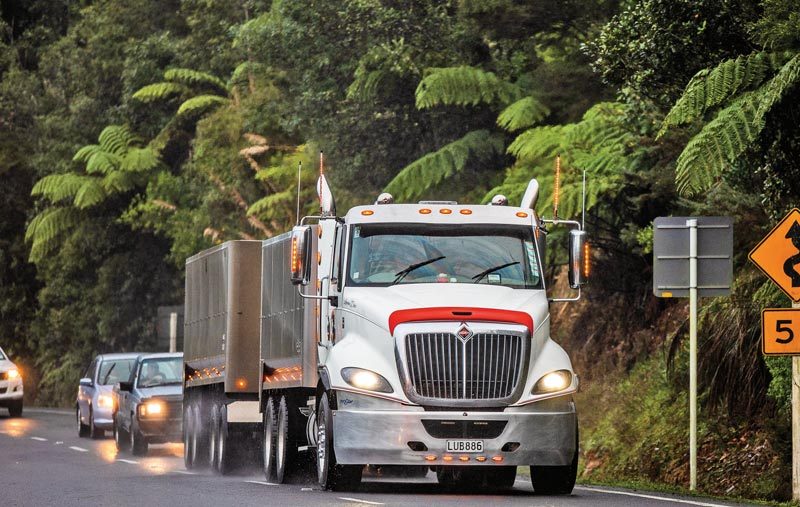
“I‘ve got a hell of a lot of respect for those guys eh, Comer, Hugh and all that. We go back a hell of a long way and I‘ve bought a lot of gear off them over the years you know. They‘re bloody top people. Top, top people!” That was how our conversation with Brian Aitchison, owner of Rangiriri-based MMM Cartage started. Brian went to great lengths to impress upon us from the start what he thinks of the International product assembled and sold here in New Zealand, and the people who form ranks in ‘these parts‘ behind one of the world‘s biggest, oldest, and most respected brands.
“I mean look at this truck, what a beautiful machine. It‘s only done 57,000 kilometres sure, but come on. This‘ll bloody do me, Dave. She‘s a bloody beauty.” We met Brian and the new International ProStar R6 in the small industrial hamlet of Kopu at the base of the Western Coromandel Peninsula. He was taking a load of aggregate from the Kaipara Ltd-owned Smythes Quarries on the fringes of the Hauraki Plains, to the Firth batching plant in Whitianga in the eastern Coromandel. It‘s a roughly 225-kilometre round trip that‘ll take a little over four hours to complete; that‘s about a 56km/h average. Climbing into the ProStar you‘re instantly greeted with a sense of lightness and airiness, along with an immediate appreciation of the cab‘s visibility. For us there are instant flashbacks to the Kenworth T360 launch. But what makes the ProStar so cool is this ain‘t no concrete mixer. As you settle in and Brian sets sail, that sound coming from the pointy end is so familiar, as is the rate of progress!
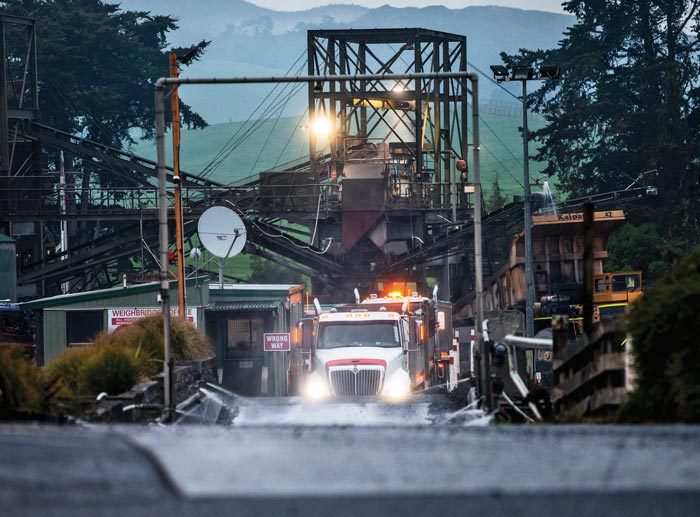
Photo: Quarry life, and Lonesome Dove is blazing the trial.
Lonesome Dove
Brian‘s a one-man one-truck operation subcontracting to Kaipara Ltd delivering all manner of aggregate to all manner of customers in the broader Auckland region and as far afield as required, the Coromandel being a prime example. The ProStar replaced an International WorkStar, also bought new from Intertruck Distributors (NZ) Ltd. “The WorkStar was a good machine but just struggled a bit on these sort of runs,” said Brian. “We come out here quite a bit so an upgrade was needed. The WorkStar had the company [N 13] 475 horsepower engine, and like I say was honest, but this is a whole different ballgame, this just eats it, eh mate?” The truck‘s name, Lonesome Dove, came about for two reasons. Firstly, Brian rates the Brad Pitt film of the same name as one of his favourites, and second, this ProStar is the first one sold into ex quarry to customer aggregate distribution. As Brian pointed out, there‘s been a number sold on more bulk and linehaul tip work, but the task of delivering direct to customers on a continuous basis from a big hole in the side of a hill is Lonesome Dove‘s trail to blaze…and blaze it she most certainly has.
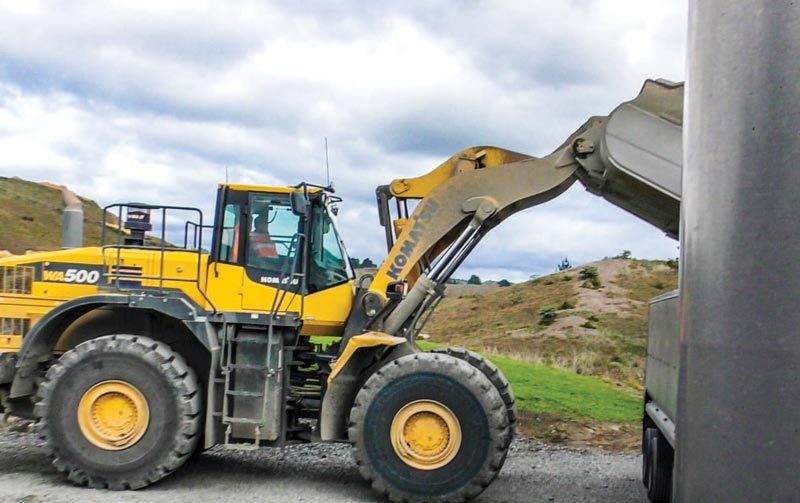
Photo: Turnaround times are down to just a few minutes.
So you wanna cart some stuff?
The sleek, elegant and socially unobtrusive snout of the ProStar belies the brute lurking within. Up front is our old friend the Euro 5 Cummins X15 coupled Quarry life, and Lonesome Dove is blazing the trial. to an Eaton two-pedal UltraShift PLUS 18-speed automated manual transmission (AMT), meaning it has ADEPT (Advanced Dynamic Efficient Powertrain Technology). Just to recap, in Cummins/Eaton speak, ADEPT means if this US sourced driveline was a family it would be the Waltons, a harmonious productive union with never a cross word. The ADEPT smarts (SmartTorque and SmartCoast) optimise the engine‘s performance and fuel burn via a constant electronic conversation between the X15 and transmission on interesting topics like load, speed, and grade. Brian‘s gone for the engine rerate option and the ProStar‘s red warrior pumps out 459kW (615hp) at 1800rpm and 2780Nm (2050lb/ft) of torque between 1100 and 1600rpm. Bearing the burden of all this prior to its arrival at the gearbox is an Eaton Fuller ECA (Electronic Clutch Actuation) 15.5” twin-plate 7-spring clutch, the ECA bit meaning ‘no pedal Pal‘.
Front axle is Meritor MFS 16-143A Wide Track rated at 7.25 tonne with 50° wheel cut on 3-leaf parabolic springs and shocks. Bringing up the rear are Meritor RT46-160GP axles at 4.1:1 with independently operated inter-axle and cross-locks. The driven pair ride on IROS (International Ride Optimised Suspension) 4-bag suspension. Brakes are drum with EBS (and ABS) and auto slackadjusters, and the Jacobs Intebrake takes care of the auxiliary anchors. Obviously disc brakes are an option. So that‘s ‘how‘ the ProStar carts its stuff, but it‘s the amount of ‘stuff ‘ that determines whether or not you make more money, and that‘s an area International have always been strong in. Brian runs the 7-axle unit on standard weights, but with the truck ready to receive its first bucket full at 9500kg tare and the Transport and General Transport Trailers 4-axle trailer at 5400kg, he can still dump over 30,000kg out the back doors without all the HPMV palaver. Handy.
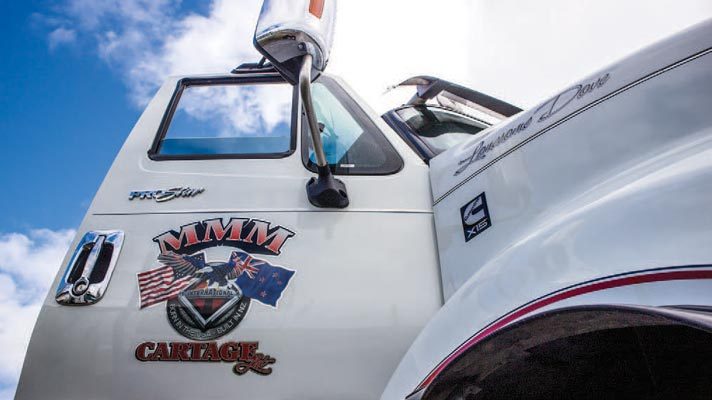
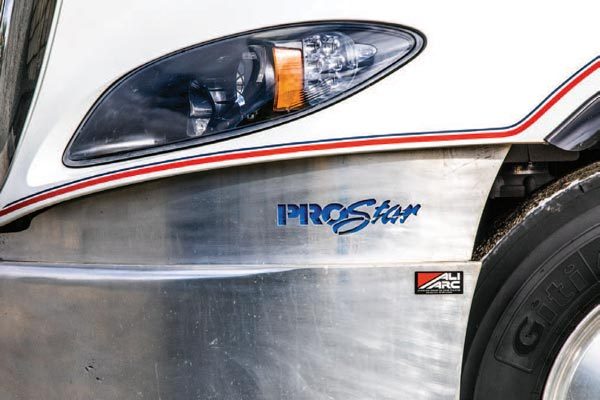
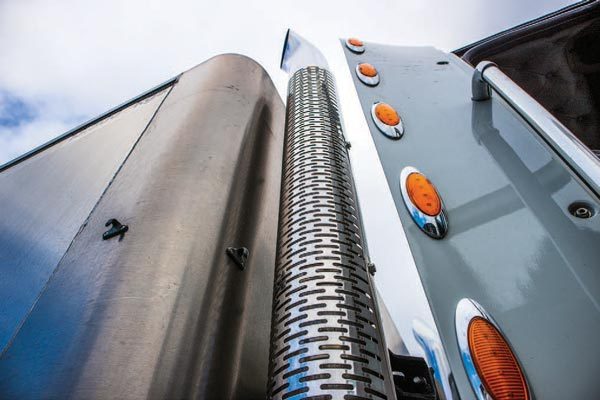
Show me a hill
Okay, let‘s. How about a state highway that still holds the title of the most recent one to be surveyed and cut as a whole new road through a previously unbreached main divide, the Coromandel‘s State Highway 25a, known locally among the fraternity as the Kopu-Hikuai or ‘Kopu-Hik‘. Opened in 1967 and sealed end-to-end by 1973, the road forms the main artery from western Coromandel to the east, and harbours some significant truck traffic on a daily basis. Because the road cut a new path for a considerable portion of its length, there was no need to conform to corner radiuses originally intended for horses and the like.
That being the case, the government of the day decided if they were going to spend the dosh they‘d future-proof it by stipulating that no corner was to have a safe cornering speed of less than 30mph. That was fantastic foresight – yes, we know what you‘re thinking – and means the road is not crippled by switchbacks a la Mt Messenger and co, and still forms a more than effective carriage to this day. The Kopu-Hikuai rises from sea level some 400m to its highest point before descending back to sea level again. It might not break too many records on summit heights, but its design and construction mean it‘s an epic truck pull! Just like the Kaimais a tad further down the range on the other side of Mt Te Aroha, if you want to know what she‘ll do, this road is your boy.
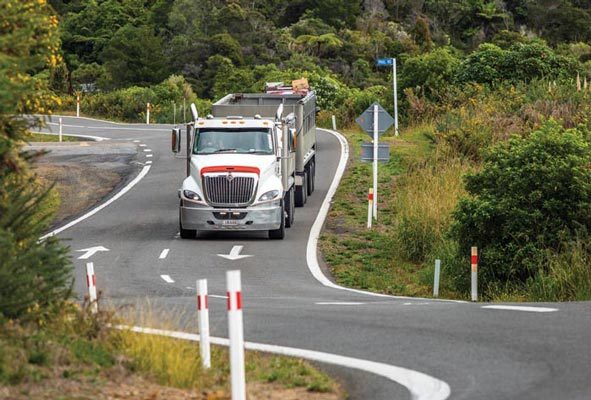 |
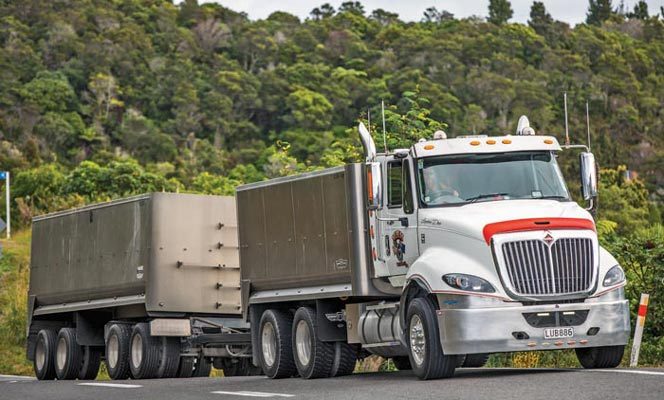 |
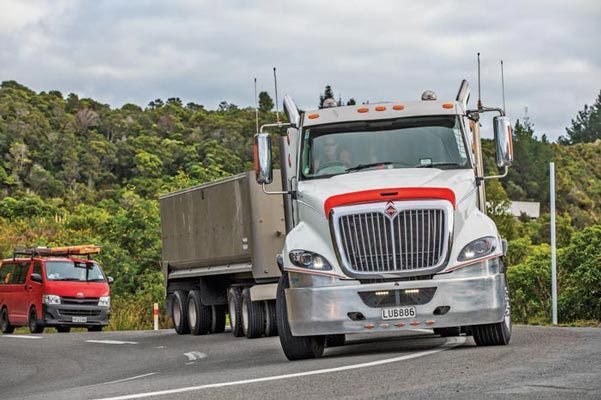 |
Photos: The constant turns and undulations on the Tairua hill. Brian takes a wide swing on the summit corner.
…so let‘s see
It wasn‘t long before the horses corralled beneath the ProStar‘s snout were out for a gallop. It‘s not always just sheer guts up a climb that saves precious seconds: winding our way steadily up the Kerikeri Valley toward the base of the main divide, the truck‘s ability to slow for the corners that come one after another and then accelerate back to an acceptable straight line speed before buttoning off again, was clearly evident. In these conditions a capable truck will be less than a speck in the mirrors of an athletic truck before the real climbing even starts, and that pretty much summarised the WorkStar/ProStar difference. With today‘s big iron, even if they slip off the sweet spot for whatever reason, 90 percent of the time you can just put them back there with the throttle. The challenge as we see all too often nowadays, sadly, is not letting the horses gallop off. There are no worries on that count in this office. It was an effortless progression and the ProStar‘s capabilities were by far the most significant contributors to the relaxed in-cab environment.
The Kerikeri No 2 bridge marks the start of serious ascension and the ProStar was into it. The steepest part of the west to east transit is on this first stage up to what‘s known as ‘Huck‘s flat‘, and the truck momentarily sees 38km/h in 11th and 1600rpm. Once again, Brian drives the truck in manual when things are ‘serious‘, and is adamant about where he wants his charge to spend its day. “I drive it between 1550 and 1850rpm, Dave,” he said. “That‘s where I‘ve been told to drive it for longevity, and the people who gave me that advice know their stuff when it comes to a Cummins. And it‘s proving itself in terms of economy; the engine must be happy because it‘s returning a steady 2.2kpl even this early in its life.”
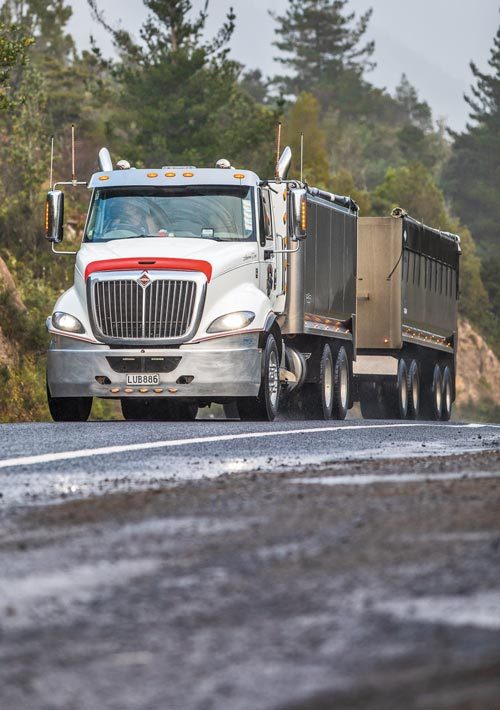
Photo: The ProStar crests the Stadia hill on the Kopu-Hikuai Road.
It‘s a very Craig Kelly [Uhlenberg Haulage] approach to driving. Brian says the torque is one of the truck‘s most impressive features, which is fair comment because even though he‘s choosing to operate it in the top half of the performance band, the engine is still almost at the torque peak when Brian‘s bottom number of 1550rpm comes up. Add the impetus that driving the truck in the power band (rather than the torqueband) provides, and you‘ll need topography‘s equivalent of the Hulk on a grumpy day to beat it into submission. Over the summit and it‘s down a long continuous gradient the thick end of four kilometres long that winds through box cuttings and finishes with a long, steep, straight section through a rock canyon called the Andesite cut, the scene of many a flaming brake drum. Luckily it in turn rolls out on to a long straight known as the ‘one tonne straight‘ (for obvious reasons) that‘s been a lifesaver for many a truck driver, and a licence loser for many a youth and motorcyclist. Thankfully there were no dramas in store today. Brian is an old-school descender in every sense of the word, a living lesson in how to get 48 tonne to the bottom of a ravine with no fuss and bother.
In fact, his approach is worth further consideration given the X15‘s Intebrake traits. We‘ve talked before about the performance of the Jacob‘s Intebrake in mid-range revs, delivering 336kW (450hp) at 1500rpm, and that‘s exactly where Brian uses it. “Mate, I pay the bills, and engine brakes aren‘t easy on engines. I hear other drivers with the engines right at the top end with the engine brake screaming. This is plenty good enough around 1500rpm.” The ProStar found its way down from the summit with a controlled note to the engine brake and just an occasional brush on the brake pedal. Driving trucks is about managing energy; the minute you understand that your whole life changes. Brian‘s a master at it, the truck feels like it‘s in energy balance – a neutral sort of feeling – all the time. Leaving the summit without a backlog of pent-up energy in residence all through the truck meant the trip to the bottom was a doddle for machine and occupants. Bushes, bearings, brakes, and lower backs were all blissfully relaxed.
Back to old school
Off the Kopu-Hikuai Road and it‘s a return to more typical pioneer road turned highway. State Highway 25 north of Tairua to Whitianga is your typical Kiwiana coastal road. First up is Pumpkin Hill, steep in places and winding with tightly radiused corners, and Brian taps away at the shift button and the Eaton clicks away at the gears. A hill that‘s stranded the odd lorry on its in-bends passes effortlessly beneath the tyres. It appears man‘s machines have at last conquered this country. Taking performance numbers is a waste of time as the truck has to slow while climbing for corners. The cool thing is, even uphill at 48 tonne, it romps away from one hairpin up to the next.
That barrier gone, the road curves, dips, and rises as it cuts through the farmland of Whenuakite and Coroglen, formed on the solidified lahar trails that once flowed from New Zealand‘s oldest volcanic chain. This Coromandel is a great place to test every aspect of a truck you can think of, and this particular area is known for inducing back pain, as the cornering speeds are often just enough to load up the lower back. If you‘re going to spend any length of time here, then a bonneted truck with a more central driving position that‘s easy on the ‘Gs‘ is the bully. Alas, VDAM makes that an ‘I wish‘ for most. Being a 6×4 and carrying its load, the ProStar looked after its occupants admirably and any jolts were the fault of shortcomings in the NZTA‘s ‘fit for purpose‘ department, not the truck. The ride was smooth and firm, typical US and typical of a front rubber, 2-airbag cab set up. Noise-wise the International bobbed around the 70 to 72dB mark, about par for this genre, if not a tad better than average; on the right surface high 60s were duly noted. Rattles and bangs-wise the ProStar was absolutely exemplary and a credit to her Mt Maunganui assemblers. It‘s not something that can be said for all trucks, even ones you expect to be squeak-free. The ProStar gave a five-star performance in this area at 57,000km
Brian said the steering and directional control was superb, as were the brakes, something we‘ve always found to be the case with Inters, even right back to 3070 days to be fair. The width of the cab, blandness of the bonnet, and lack of any visible emblem means placing the truck is something you learn on the first morning of ownership. It‘s like driving a bonneted truck in a cabover placement…almost. The wide-cab conventionals are sort of their own thing really. Brian‘s well versed by now and the ProStar‘s snout cut a true and faultlessly stable path all the way.
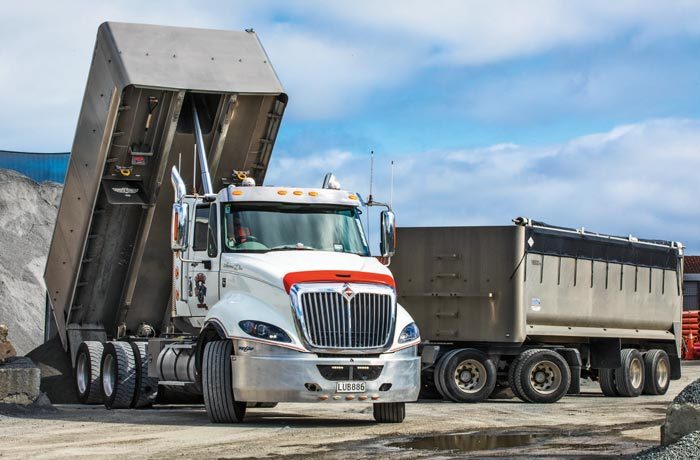
Photo: The ProStar‘s a nimble, agile, productive performer.
Musings while motoring
The ProStar‘s one of those trucks you could bring home, park in the street, and it wouldn‘t really worry the neighbours. It doesn‘t brazenly announce itself in the same way as a Kenworth T909 and risk the pursed-lip peeking of busybody eyes from behind curtains. The ProStar would simply glide into place just on dusk and a solitary dog about 600 metres away might bark once. Some people prefer the ‘here I am‘ thing, but to guys like Brian Aitchison who have done the endless miles, the over the top bravado and attention seeking are now even beyond memory. They want a capable, productive machine with notes of individuality. For them, success is not the number of empty Autosol tubes in the drum out back, it‘s a balance sheet that reflects the effort they‘ve put into it, and a smart, reliable, wellsupported rig that‘s done a decade‘s worth of graft without ever having felt the wrath of a panel beater‘s hammer.
By the time this mag is in your hands, the ProStar will have found itself in familiar International shoes when you think back to the halcyon days of S and T Lines. Kenworth‘s announcement that the new T410 won‘t come packing red-punch, along with the need to go ‘big dog‘ in the Mack stable to secure 600hp, means the ProStar now offers something the others can‘t – a truck just like Brian‘s. Yes, sometime soonish the Cascadia will arrive and offer some level of option. However, for now, it‘s the ProStar that satisfies a driver‘s desire for thrust, a fleet owner‘s desire for practicality, or an SME‘s desire to break into new gear. And of course, the great news in 2019 is there are now the model options to stay with the brand as your fortune amasses, and mark your place on the nation‘s roads with bucketloads of ‘spectacular‘ if that‘s your desire, an option that wasn‘t really there all those years ago. And for all this we have Comer Board to thank.
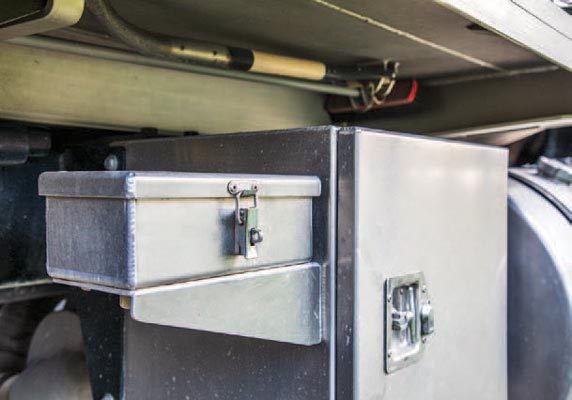 Photo: Now that really is a glove box.
Photo: Now that really is a glove box.
Marching on
Winding through the countryside toward Whitianga we discuss the decision to go for the push-button AMT. “I went for the push-button option because I never really took to the Cobra shift in the WorkStar. I find the push button module easy to use. As for AMT versus manual, there are two reasons: space and the city work. You‘d be surprised how much room the gear lever and clutch take up,” Brian says, as he waves his hand around the void between the seats. “The leg room is great too, just more room. Then there‘s our work. You don‘t know what you‘ll be doing next. If we‘re carting out of say Brookby Quarry (southeast Auckland) into somewhere like East Tamaki, you won‘t see top gear at all. All you‘re doing is changing, changing, changing. The auto comes into its own then.”
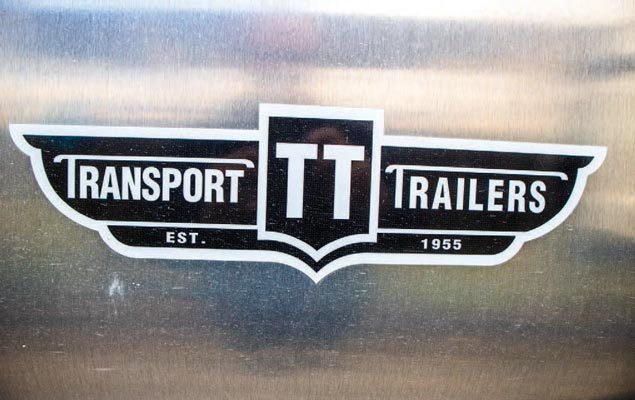

On runs like this the ability to make the most of the ADEPT‘s coast and power optimisation functions are limited. The run across the Hauraki Plains from the quarry is cruise territory no question, but there are no undulations that allow the truck to coast. Following that you drive into the hills and then there‘s no flat! With experience you might be able to extract a couple or three coasting bursts on the run through the Whenuakite and Coroglen farmland, but again, it‘s going to be limited opportunity and short-lived at that. There are plenty of places in Brian‘s work area where you could utilise the functionality though; it‘s something that might be worth a play with. After all, every litre of fuel saved is money in the bank. Into Whitianga and Brian tips the load off into the bin. It‘s an unhook one at a time site, and the visibility the raked bonnet and expanse of glass afford come into their own.
Likewise, the International‘s lock makes tiki-touring around the yard a piece of cake. Deliveries like this are no issue at all, but Brian also said the truck‘s IROS suspension and traction aids, together with the optimal configuration, afford great traction. “Even jack-knifing it never complains, pulling out and straightening the loaded trailer, then back in. Yeah, it‘s real good.” Having the UltraShift PLUS means there are creep mode and hill-starting aids also. Load off and heading out of town the ProStar returns home as quick as any car. Brian flicks the gearbox into auto and lets the International take over while we chat about all manner of things.
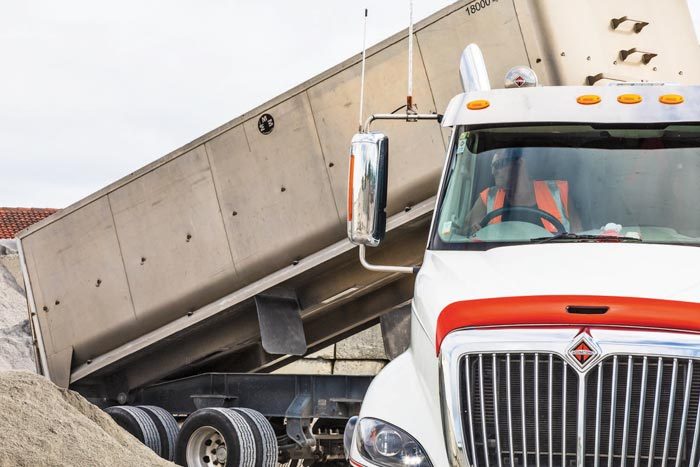
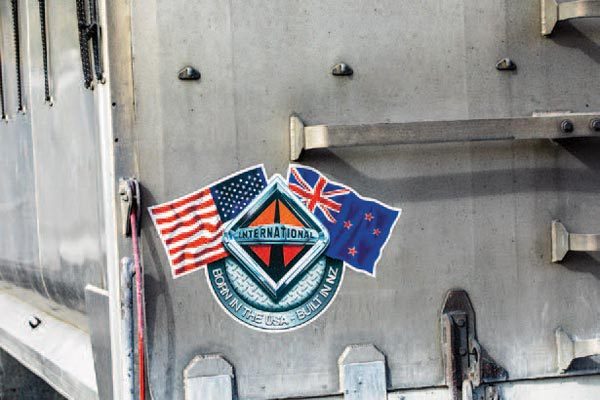
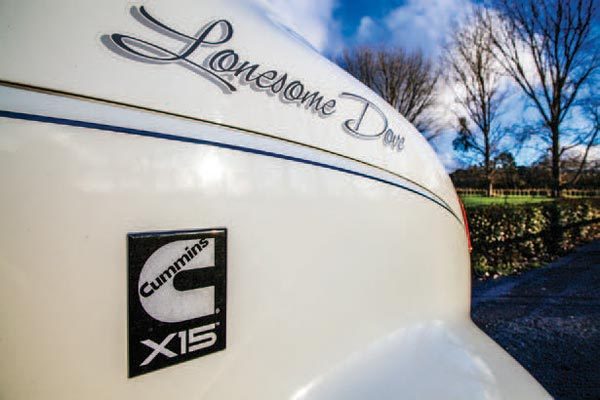
Summary
Standing back and looking at the truck after unloading there‘s no question the ProStar ticks many 21st century boxes. It undoubtedly has a high social acceptance factor with its clean lines and unobtrusive presence…low on ostentatiousness you might say. But that‘s all a clever mask, because underneath is a powerhouse that could well come into its own rapidly. The fact the ProStar offers the red engine option must surely win over some T409 customers if managed well by the Intertruck team, and the sharp end of that strategy must surely hinge on productivity and what their machine can carry. After all, who doesn‘t like cash in the bank.
We thought the ProStar was extremely well put together and the cab moved in silence as its structure was propelled around the Coromandel. There‘s no questioning an International‘s mechanical tenacity when it comes to doing their best for their owner‘s bottom line. The emblem has a place in history few can live with. Add to that the support from a group whose passion for what they do has earned both themselves and the marque a special place in the annals of New Zealand‘s road transport story, and it‘s a clearly a case of long live the icon.
MORE MAIN TEST READS BELOW..
Land of the Long White ProStar
It‘s a great trivia question. Who are the world‘s top five truck manufacturers? Sadly, nine times out of 10 you‘ll take the booty on that one, as few will likely include Navistar, which rolls in at number four. The Illinois-based US company‘s vast array of highway, vocational, and military vehicles catapults its annual product headcount into the over-300,000 unit category. You certainly won‘t spend much time in the States on the side of the Interstate before the famous badge rolls on by. But of course our ProStars are special. Special because they‘re assembled right here at Mt Maunganui at the incredible place that is Intertruck Distributors (NZ) Ltd.
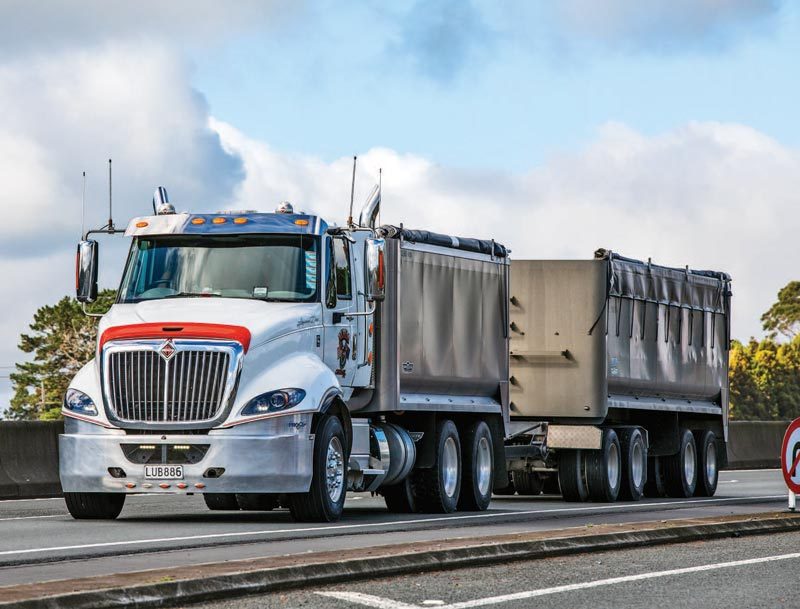
Like the 9870, the ProStar is a parts list assembly so there is no kit as such. The main difference between the two trucks is the ProStar cabs come in trimmed and are customised here. The local assembly counts for a whole lot, especially when things change, things like Vehicle Dimension and Mass (VDAM). Because the Intertruck design and assembly operation can rapidly tweak things like critical axle spacings to maximise opportunity in the local compliance environment, they‘re able to offer tailored vehicles.
Take the 8×4 ProStar conventional. The company build an R8 and T8 variant with different front axle spacings to optimise the worlds of application and compliance. There‘s a level of flexibility and agility not available anywhere else. Kiwi-assembled ProStars are fully integrated on the Navistar build portal, meaning customers can see their truck in build and the components that go into it. And then there are the parts. Because there‘s an assembly operation here, a truck won‘t be left off the road at a service agent due to a lack of bits. “We don‘t appreciate the level of expertise and passion there is here for the product,” says Brian Aitchison. The Internationals are also available with the in-cab fatigue monitoring Guardian System, as well as the full Bendix Fusion suite of safety features that includes ESP, lane departure, collision warning and mitigation.
Wide-eyed!
When it comes to wide-cabbed conventional trucks pretty much everyone else is playing catch-up when compared with International. Bonnets and breadth have been an International hallmark for decades and seen by many over the years a compelling purchase pro, even if the S-Line‘s complimentary central heating was somewhat of a con. The ProStar carries the fine tradition of cab width on, but with a 21st century level of refinement. The cab itself was not unfamiliar here when the ProStar arrived in 2017, having been the one used in the relatively short-lived Navistar CAT JV. However, it‘s here now in its own right, as it should be, with an International badge.
 |
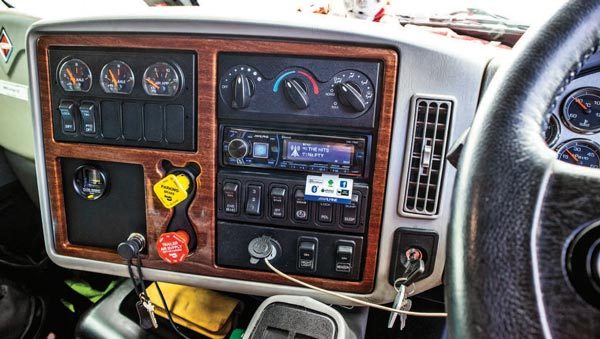 |
| Photo: The binnacle is clear and classic. | Photo: The wrap falls within easy reach. |
If aerodynamics is your thing, then so will be the ProStar. It‘s reputedly the slipperiest big conventional in the real world, whether it‘s headwind, or cross. Getting an actual coefficient figure is not easy, I guess in part due to the options there are for making them more, or less, slippery through the air, and the unknown of what‘s in tow. Getting a comparative figure is equally hard, so there‘s not a lot to be gained. Looking at the truck though, the ProStar‘s arrow-like shape makes its aerodynamic prowess obvious.
The BBC measure on the day cab is 2870mm, which places it in the top two contenders in the setback front axle conventional truck market. Tying in with that comes the startling visibility. The rake on the bonnet is severe; from the seat your eye is just able to follow its line down to the grille, and there‘s the road, right there! Depending on how tall you are, you‘re seeing the road surface about four metres from the front bumper. Put it this way, from the ProStar‘s driver‘s seat you‘ll see a dwarf on a Lime scooter at the lights, no problem. Because the mirrors are more orthodox in style and placement it doesn‘t have the right-left clarity of view that the 2.1 Kenworth cab does, but it‘s a leap ahead of nearly all cabovers and on a par with its other bonneted brethren. The cab‘s a US house for sure, with 10 gauges in front of the driver in an elegant round-topped binnacle, with a modular wrap housing switchgear, climate, brake valves, and entertainment. There‘s no infotainment centre or vehicle/ driver telemetry to speak of at this stage.
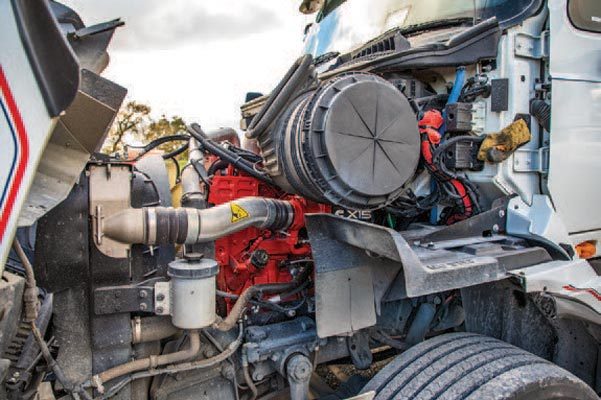 |
 |
| A snug residence for the red one. Amazingly unobtrusive in the cab. Daily checks are easy, and of course Brian, like Rex Stephens last month, is a religious daily checker. |
The shift module in the ProStar is a push-button job just down to the driver‘s left. It‘s easy to see and works fine. It‘s an interesting digression for a moment, the AMT control options. For well over half a century we never really had a discussion about how you change gear in a truck. MAN had a column shift manual option years ago, as did one or two others, but the people who thought them up were probably made available to industry within weeks of launch – well, we hope they were. But now we‘re all deciding if we like buttons on boxes, Cobra stalks, or busy little wands with a million things happening on them. Soon, we won‘t have to worry, they‘ll all be gone, there‘ll just be ‘F‘ and ‘R‘ and they‘ll probably be voice-activated. Anyway, back to the cab…
The steering‘s adjustable for telescope and rake and there are in-spoke controls for cruise. On the left side of the steering column is the dip, wiper, and indicator wand, and on the right the trailer control. Brian rides on an air seat with all the necessary adjustments. The ProStar‘s accommodation is mounted on rubber blocks front, and airbags rear. The MMM truck has the top trim package in grey tones with diamond patterned vinyl on the hood lining and rear cab panel, along with flashes of Rosewood, heavy wear plastics, and rubber on the floor. It‘s an ideal set up to keep looking smart in this line of work. A good hour with the vacuum and rag and she‘s bonzer.
 Photo: Light, airy, and as spacious as you‘ll get in a day cab bonnet. AMT with no left pedal maximises the room.
Photo: Light, airy, and as spacious as you‘ll get in a day cab bonnet. AMT with no left pedal maximises the room.
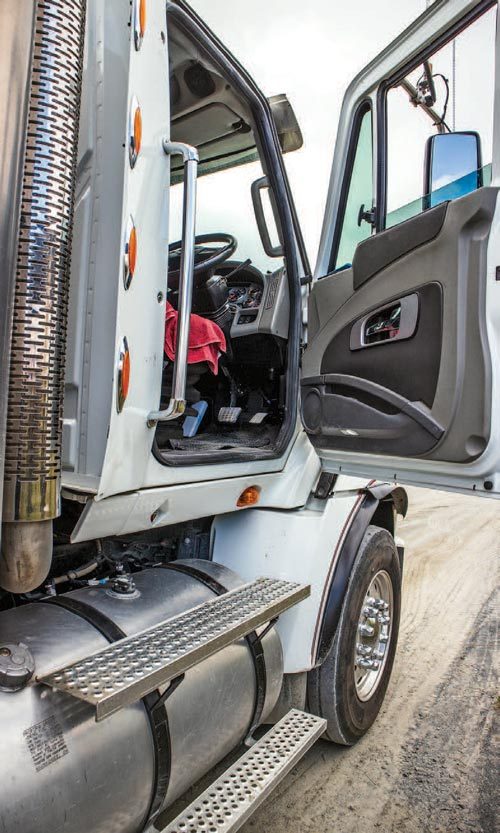 Photo: The ProStar‘s low lines make breasting the driving department an absolute doddle.
Photo: The ProStar‘s low lines make breasting the driving department an absolute doddle.
Storage-wise these trucks are always a challenge, but the ProStar‘s enhanced with the optional centre storage cubby between the seats to complement the overhead cubbies and door pockets. Brian puts the cooly bag in front of the cubby and he‘s away. On the outside, access is really good with plenty of handles and wonderfully cascaded steps. It‘s a cab you sort of walk into, sort of like an R Model Mack with the old recessed tank step, except the door actually opens and it‘s completely different…never mind. If you get it, you‘ll get it. I guess we‘re saying low, sleek, conventional trucks are a piece of cake to get into. Beneath the bonnet nestled down there is Big Red. It‘s a snug fit with minimal cab intrusion considering what they‘ve put where. An engineering marvel.
No dress rehearsal!
What New Zealand schools need are careers advisors who aren‘t the run of the mill, over-planning, over-thinking type, the sort who help make our kids way too complicated way too early. We need more who understand that kids are free spirits about to launch themselves on a planet full of opportunity. We need the Brian Aitchisons of the world to be mentors and career advisors. We think he‘d probably dispense advice like ‘Life‘s a gift to be enjoyed, life‘s an adventure to be had, life‘s a challenge not to be afraid of, life‘s a mat to get back up off when you‘ve been knocked down. Life‘s the people you interact with every day, so make it positive and say sorry when you need to; and most important, life‘s not a dress rehearsal.‘ That‘s our guess anyway, because from what we saw that about summed up Brian.
This 67-year-old 30-year-old starts every day with weights. Not aggregate – free weights. “You have to look after yourself, Dave. Half an hour in the morning just to get things moving and keep you upright and flexible, because you can get stooped easily in this job, eh.” Six decades and seven years into the adventure, paying for a new truck, striding around unhooking trailers, darting here and there, hungry for the next load, stopping to buy Pam, the office lady at the quarry, her favourite pie from the bakery in Tairua. Brian‘s not rehearsing, he never has, he never will. Wairoa-born, Brian was adopted out after the death of his mother. His childhood in Cambridge hadn‘t been a bucketful of the fondest memories for the irrepressible young man when he cut out and headed for a carpentry apprenticeship through the Department of Maori and Pacific Island Affairs at the age of 16. Three years into that and the urge to drive trucks was too great so he started working for Bruce Clothier at Waharoa Transport. But it wasn‘t long before an inherent sense of adventure saw him head for Australia, having organised a
Read more
The right man for the job
0 Comments29 Minutes
Legendary ambition
0 Comments36 Minutes
Hard Fought!
0 Comments40 Minutes
Postal Trifecta
0 Comments29 Minutes





